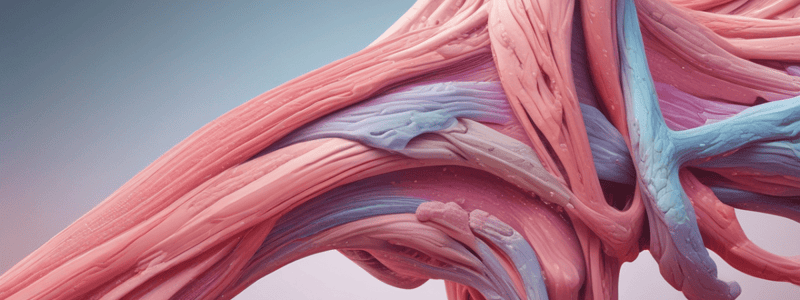Podcast
Questions and Answers
Muscles are responsible for the movement of the body and organs within the body.
Muscles are responsible for the movement of the body and organs within the body.
True (A)
The contraction and relaxation of muscles are due to the movement of tiny filaments in muscle tissues.
The contraction and relaxation of muscles are due to the movement of tiny filaments in muscle tissues.
True (A)
Voluntary muscles, like those in the limbs, are under conscious control of the nervous system.
Voluntary muscles, like those in the limbs, are under conscious control of the nervous system.
True (A)
When one wants to bend the elbow, the brain instructs the triceps muscle to contract.
When one wants to bend the elbow, the brain instructs the triceps muscle to contract.
Involuntary muscles, like those in the heart, perform contractions under conscious control.
Involuntary muscles, like those in the heart, perform contractions under conscious control.
Contraction of one muscle is always accompanied by contraction of another muscle.
Contraction of one muscle is always accompanied by contraction of another muscle.
Head and neck muscles are mainly responsible for breathing.
Head and neck muscles are mainly responsible for breathing.
Trunk muscles include thoracic muscles, muscles of the back, and abdominal muscles.
Trunk muscles include thoracic muscles, muscles of the back, and abdominal muscles.
Pelvic muscles assist in breathing movements.
Pelvic muscles assist in breathing movements.
Upper limb muscles have their bulk located at the pelvis.
Upper limb muscles have their bulk located at the pelvis.
Lower limb muscles are not very powerful compared to other muscles in the body.
Lower limb muscles are not very powerful compared to other muscles in the body.
Voluntary muscles, such as those in the limbs, perform involuntary contractions and relaxations.
Voluntary muscles, such as those in the limbs, perform involuntary contractions and relaxations.
Involuntary muscles, like those in the heart, are under the control of the autonomic nervous system.
Involuntary muscles, like those in the heart, are under the control of the autonomic nervous system.
Muscles always work independently without coordination from other muscles.
Muscles always work independently without coordination from other muscles.
The brain instructs the triceps muscle to contract when one wants to bend the elbow.
The brain instructs the triceps muscle to contract when one wants to bend the elbow.
All movement, including the movement of organs within the body, is carried by bones composed of tissues.
All movement, including the movement of organs within the body, is carried by bones composed of tissues.
The contraction of muscles is solely due to the movement of tiny filaments in muscle tissues.
The contraction of muscles is solely due to the movement of tiny filaments in muscle tissues.
Trunk muscles include thoracic muscles, muscles of the back, and abdominal muscles.
Trunk muscles include thoracic muscles, muscles of the back, and abdominal muscles.
Pelvic muscles assist in breathing movements.
Pelvic muscles assist in breathing movements.
Upper limb muscles have their bulk located at the pelvis.
Upper limb muscles have their bulk located at the pelvis.
Lower limb muscles are among the most powerful in the body.
Lower limb muscles are among the most powerful in the body.
Head and neck muscles are mainly responsible for breathing.
Head and neck muscles are mainly responsible for breathing.
Flashcards are hidden until you start studying




